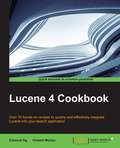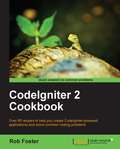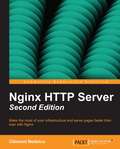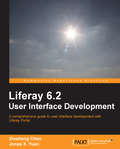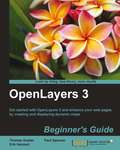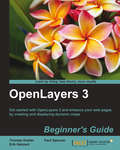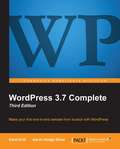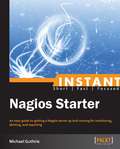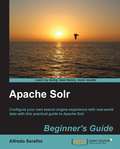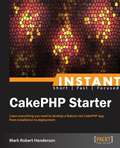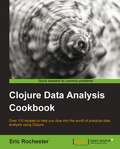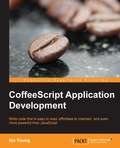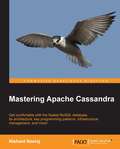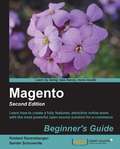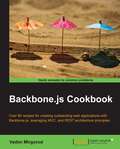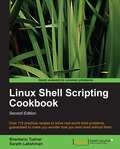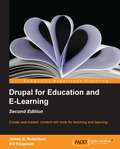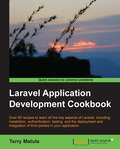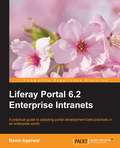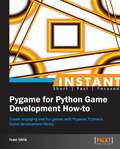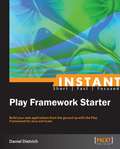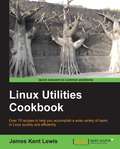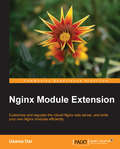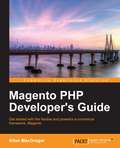- Table View
- List View
Lucene 4 Cookbook
by Edwood Ng Vineeth MohanThis book is for software developers who are new to Lucene and who want to explore the more advanced topics to build a search engine. Knowledge of Java is necessary to follow the code samples. You will learn core concepts, best practices, and also advanced features, in order to build an effective search application.
CodeIgniter 2 Cookbook
by Rob FosterPresented in a recipe-based format, you are led step-by-step through each aspect of CodeIgniter, allowing you to dip in and out as you choose.CodeIgniter 2 Cookbook is for intermediate to advanced PHP developers who want to begin using the powerful CodeIgniter framework to create web applications. Familiarity with CodeIgniter isn't essential, but it will be useful if you have been introduced to the framework before.
Nginx HTTP Server Second Edition
by Clement NedelcuThis tutorial book includes detailed instructions for each of the processes it describes: downloading and installing the application, configuring and using modules, and much more. It provides a step-by-step tutorial to replace your existing web server with Nginx. With commented configuration sections and in-depth module descriptions, you will be able to make the most of the performance potential offered by Nginx.By covering both early setup stages and advanced topics this book will suit web administrators interested in solutions to optimize their infrastructure, whether they are looking into replacing existing web server software or integrating a new tool cooperating with applications already up and running. If you, your visitors and your operating system have been disappointed by Apache, this book is exactly what you need.
Liferay 6.2 User Interface Development
by Xinsheng Chen Jonas X. YuanA step-by-step tutorial, targeting the Liferay 6.2 version. This book takes a step-by-step approach to customizing the look and feel of your website, and shows you how to build a great looking user interface as well."Liferay 6.2 User Interface Development" is for anyone who is interested in the Liferay Portal. It contains text that explicitly introduces you to the Liferay Portal. You will benefit most from this book if you have Java programming experience and have coded servlets or JavaServer Pages before. Experienced Liferay portal developers will also find this book useful because it explains the latest technologies used in the Liferay Portal. This book is a good reference for Liferay architects as the book also explains different technologies for portlet development and their strong and weak points.
OpenLayers 3 Beginner's Guide
by Thomas Gratier<P><P>About This Book <P><P>Create and display maps online with the latest HTML5 features available, using the OpenLayers 3 library <P><P>Learn how to interact with the map and learn best practices to improve the loading time for a map <P><P>A practical beginner's guide, which also serves as a quick reference with useful screenshots and detailed code explanations <P><P>Who This Book Is For <P><P>Whether you are a hobbyist or a professional web developer, if you wish to use maps on your website, then this book is for you. A basic understanding of JavaScript will be helpful, but is not necessary. If you've never worked with maps before, this book will introduce you to some common mapping topics and will guide you through the OpenLayers library. Experienced developers can also use this book as a reference to OpenLayers 3 components and to further enhance their knowledge. <P><P>What You Will Learn <P><P>Build a complete, real-world OpenLayers application optimized for production use <P><P>Work with different raster data sources to create a base map <P><P>Overlay vector data sources and work with vector features directly <P><P>Customize the appearance of vector layers <P><P>Understand the concept of map projections and how to use them <P><P>Manage and work with interactions such as click and touch <P><P>Work with controls to enhance the user experience <P><P>Target mobile platforms and explore challenges presented by mobile development <P><P>In Detail <P><P>This book is a practical, hands-on guide that provides you with all the information you need to get started with mapping using the OpenLayers 3 library. <P><P>The book starts off by showing you how to create a simple map. Through the course of the book, we will review each component needed to make a map in OpenLayers 3, and you will end up with a full-fledged web map application. You will learn the key role of each OpenLayers 3 component in making a map, and important mapping principles such as projections and layers. You will create your own data files and connect to backend servers for mapping. A key part of this book will also be dedicated to building a mapping application for mobile devices and its specific components.
OpenLayers 3: Beginner's Guide
by Paul Spencer Thomas GratierWhether you are a hobbyist or a professional web developer, if you wish to use maps on your website, then this book is for you. A basic understanding of JavaScript will be helpful, but is not necessary. If you've never worked with maps before, this book will introduce you to some common mapping topics and will guide you through the OpenLayers library. Experienced developers can also use this book as a reference to OpenLayers 3 components and to further enhance their knowledge.
WordPress 3.7 Complete - Third Edition
by Aaron Hodge Silver Karol KrolWordPress 3.5 Complete: Third Edition is a comprehensive and step-by-step tutorial packed with screenshots and examples to make it easy and quick to pick it up.This WordPress book is a guide to WordPress for online publishers and web developers. If you are new to blogging and want to create your own blog or website from scratch, then "WordPress 3.5 Complete: Third Edition" is for you. No prior knowledge of HTML/CSS or PHP is required.
Instant Nagios Starter
by Michael GuthrieGet to grips with a new technology, understand what it is and what it can do for you, and then get to work with the most important features and tasks.A concise guide, written in an easy-to-follow format.Instant Nagios Starter is an outstanding resource for system engineers, administrators and developers, with a basic understanding of the Linux command line Readers should have access to a test system or virtual machine with Linux installed to follow the given examples.
Apache Solr Beginner's Guide
by Alfredo SerafiniWritten in a friendly, example-driven format, the book includes plenty of step-by-step instructions and examples that are designed to help you get started with Apache Solr.This book is an entry level text into the wonderful world of Apache Solr. The book will center around a couple of simple projects such as setting up Solr and all the stuff that comes with customizing the Solr schema and configuration. This book is for developers looking to start using Apache Solr who are stuck or intimidated by the difficulty of setting it up and using it.For anyone wanting to embed a search engine in their site to help users navigate around the mammoth data available this book is an ideal starting point. Moreover, if you are a data architect or a project manager and want to make some key design decisions, you will find that every example included in the book contains ideas usable in real-world contexts.
Instant CakePHP Starter
by Mark Robert HendersonGet to grips with a new technology, understand what it is and what it can do for you, and then get to work with the most important features and tasks.This book is a practical, step-by-step tutorial that teaches you about Models, Views, Controllers, scaffolding, themes, behaviors, and routing in CakePHP.This book is for those who have experience in writing HTML/CSS, and a little bit of JavaScript and PHP, and want to learn the basics of CakePHP in an engaging manner.
Clojure Data Analysis Cookbook
by Eric RochesterFull of practical tips, the "Clojure Data Analysis Cookbook" will help you fully utilize your data through a series of step-by-step, real world recipes covering every aspect of data analysis.Prior experience with Clojure and data analysis techniques and workflows will be beneficial, but not essential.
CoffeeScript Application Development
by Ian YoungCoffeeScript Application Development is a practical, hands-on guide with step-by-step instructions. Follow the smooth and easy tutorial approach, covering examples that build in complexity. By the final chapter you'll be wondering why you didn't try CoffeeScript sooner.If you are a JavaScript developer who wants to save time and add power to your code, then this is the book that will help you do it. With minimal fuss you will learn a whole new language which will reduce your application development time from weeks to days.
Mastering Apache Cassandra
by Nishant NeerajMastering Apache Cassandra is a practical, hands-on guide with step-by-step instructions. The smooth and easy tutorial approach focuses on showing people how to utilize Cassandra to its full potential.This book is aimed at intermediate Cassandra users. It is best suited for startups where developers have to wear multiple hats: programmer, DevOps, release manager, convincing clients, and handling failures. No prior knowledge of Cassandra is required.
Magento Beginner's Guide Second Edition
by Sander Schoneville Robbert RavensbergenThis book is written in a friendly, beginner's guide style with plenty of step-by-step instructions for installing, configuring, and using Magento to run your own e-commerce site. We will set up an example store in the book with enough information to adapt the instructions according to your needs.This book is for anyone who wants to create an online store using Magento. If you are a non-technical person and are discouraged by the complexity of this powerful e-commerce application, this book is ideal for you. This book would also suit someone with e-commerce knowledge but requires a guide to getting started with Magento.
Backbone.js Cookbook
by Vadim MirgorodWritten in a friendly, example driven Beginner's Guide format, there are plenty of step-by-step instructions to get you started fast!Pentaho 4.0 By Example: Beginner's Guide is the ideal companion for a wide-variety of developers. Whether you are new to the world of Business Intelligence reporting, or an experienced BI analyst, this book will guide you through the creation of your first reports in Pentaho. We assume some knowledge of the SQL language and database systems.
Linux Shell Scripting Cookbook, Second Edition
by Shantanu Tushar Sarath LakshmanThis book is written in a Cookbook style and it offers learning through recipes with examples and illustrations. Each recipe contains step-by-step instructions about everything necessary to execute a particular task. The book is designed so that you can read it from start to end for beginners, or just open up any chapter and start following the recipes as a reference for advanced users.If you are a beginner or an intermediate user who wants to master the skill of quickly writing scripts to perform various tasks without reading the entire manual, this book is for you. You can start writing scripts and one-liners by simply looking at the similar recipe and its descriptions without any working knowledge of shell scripting or Linux. Intermediate/advanced users as well as system administrators/ developers and programmers can use this book as a reference when they face problems while coding.
Drupal for Education and ELearning (2nd Edition)
by James G. Robertson Bill FitzgeraldWith clear instructions and plenty of screenshots, this book provides all the support and guidance you will need as you begin to create your classroom website. Step-by-step tutorials show you how to use Drupal in the most efficient and effective ways possible. People new to Drupal will find a good introduction of the basics; while more experienced users will learn useful tips and tricks for using Drupal in a classroom context.If you are an teacher, tutor or an educator who wants to build a website for your classroom, be it elementary or any higher education, "Drupal 7 for Education and E-Learning (2nd Edition)" will guide you in achieving your goal at every step. No experience with programming languages, HTML, or CSS is needed to understand the examples in this book.
Laravel Application Development Cookbook
by Terry MatulaGet to grips with a new technology, understand what it is and what it can do for you, and then get to work with the most important features and tasks.A short and precise guide to get you started with EaselJS , helping you to create some cool applications and games.EaselJS greatly simplifies application development in HTML5 Canvas using a syntax and an architecture very similar to the ActionScript 3.0 language. As a result, Flash / Flex developers will immediately feel at home but it's very easy to learn even if you've never opened Flash in your life. The book targets Web designers, animators, Digital content producers, and Flash and Flex developers.
Liferay 6.2 Intranet Portal Development Guide
by Navin AgarwalThis book is for anyone who is interested in the Liferay Intranet Portal. This book is for both beginners and more experienced portal developers who need to create an enterprise intranet portal for their business. It will be handy for IT professionals who know the basics of how the portal technology works and need to integrate different open source technologies.
Instant Pygame for Python Game Development How-to
by Ivan IdrisFilled with practical, step-by-step instructions and clear explanations for the most important and useful tasks .This book is a step-by-step, short and fast paced tutorial packed with powerful recipes that will teach you how to create exciting games.This book is aimed at Python Game Developers who want to create games with Pygame quickly and easily and get familiar with important aspects of it. Experience with Python is assumed. Basic Game development experience would help but isn't necessary.
Instant Play Framework Starter
by Daniel DietrichGet to grips with a new technology, understand what it is and what it can do for you, and then get to work with the most important features and tasks.A practical, quick, and hands-on guide to the Play Framework.This book is written for readers interested in developing web applications with Java or Scala. A basic knowledge of either Java or Scala is helpful. Prior experience with Play is not required.
Linux Utilities Cookbook
by James Kent LewisA Cookbook-style guide packed with examples and illustrations, it offers organized learning through recipes and step-by-step instructions. The book is designed so that you can pick exactly what you need, when you need it.Written for anyone that would like to familiarize themselves with Linux. This book is perfect migrating from Windows to Linux and will save your time and money, learn exactly how to and where to begin working with Linux and troubleshooting in easy steps.
Raspberry Pi Media Center
by Sam NazarkoConstructed as a set of simple-to-follow, step-by-step instructions, this book will take you through numerous aspects of creating a fully functional media center with your Raspberry Pi. It is an easy-to-follow yet comprehensive guide to setting a complete media center experience using the revolutionary ARM GNU/Linux board.This book does not require any prior knowledge of the Raspberry Pi, but it does assume you are computer literate and comfortable with Mac OS X, Linux, or Windows and concepts such as installing software.
Nginx Module Extension
by Usama DarThis book is a step-by-step, example-oriented tutorial that will teach you to implement Nginx modules, as well as how to extend Nginx with core and third party modules.Nginx Module Extension is intended for advanced users, system administrators, and developers of Nginx modules. You need to have prior experience with using Nginx as a web server and basic Nginx configuration changes. You also need basic understanding of GNU tools like configure and make, in order to be able to compile the source code. Proficiency in C programming and advanced operating system knowledge on Linux kernel, for example, would also come in handy.
Magento PHP Developer’s Guide
by Allan MacgregorMagento PHP Developer's Guide is an easily accessible tutorial, designed and written to give the reader maximum understanding of the powerful Magento framework. This book is written for developers who have previous experience with PHP and PHP frameworks, such as Zend or CakePHP, and want to start developing and working with Magento. Even developers with previous experience with Magento will find the book extremely useful to gain a full understanding of Magento fundamentals, architecture, and overall philosophy.
